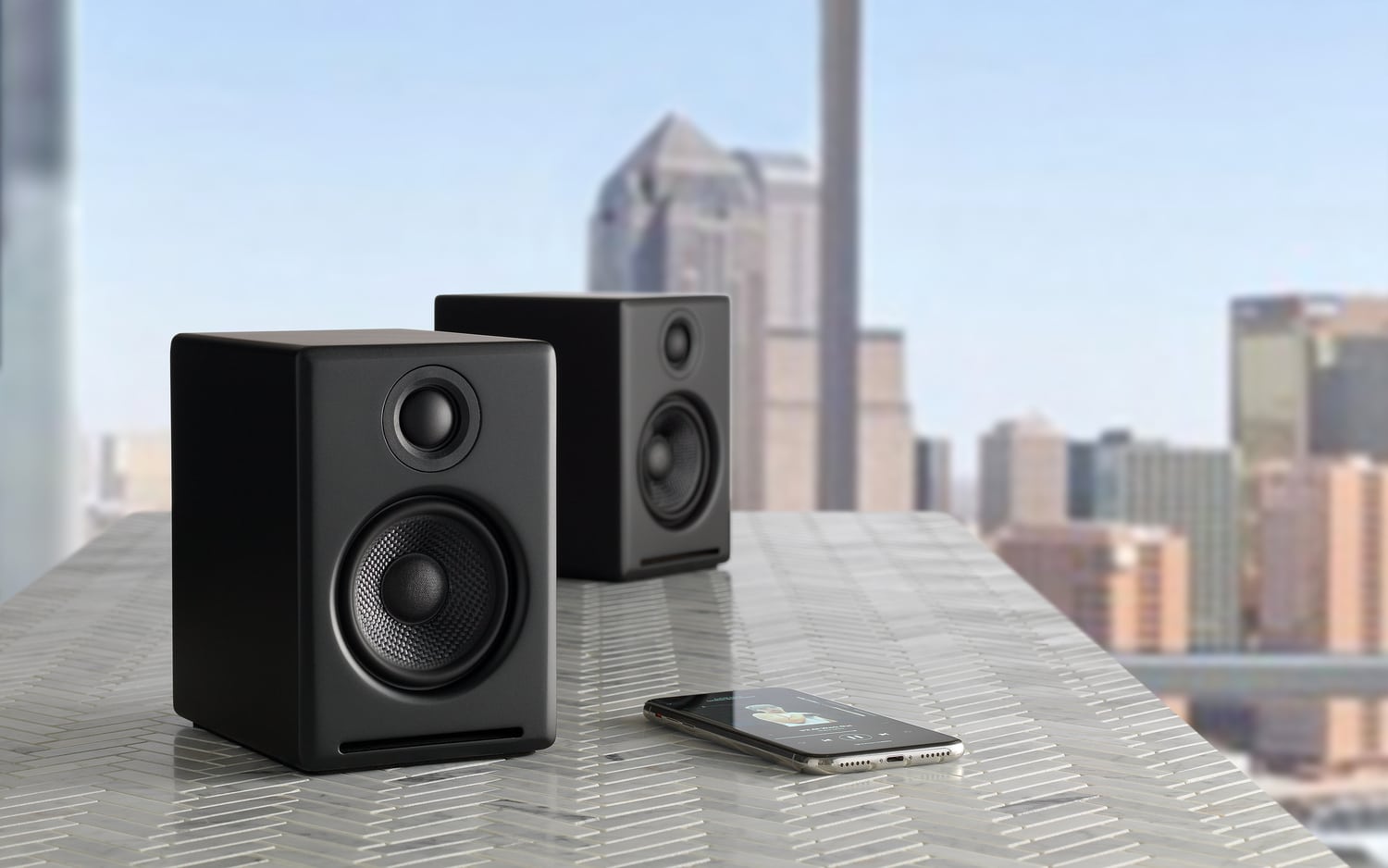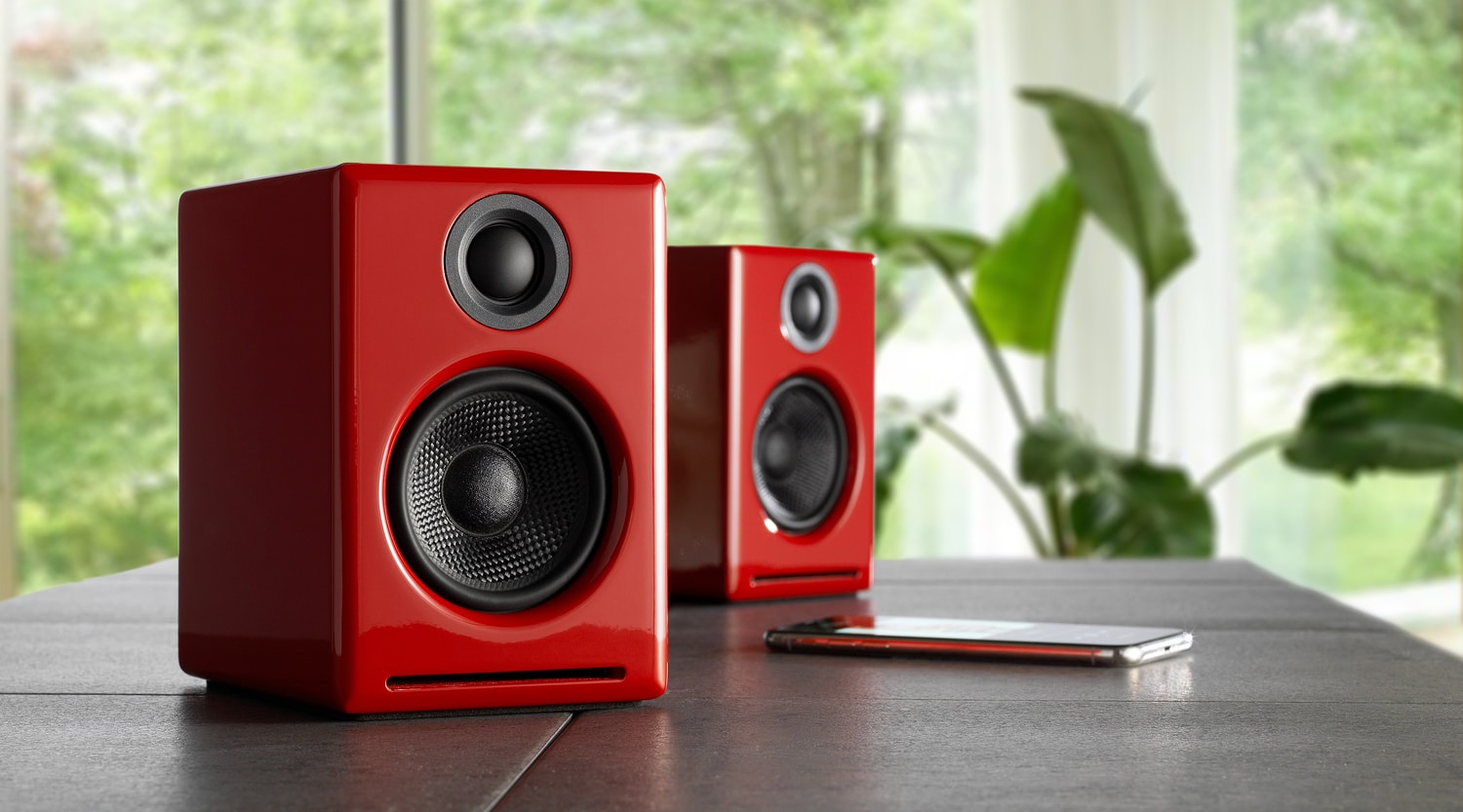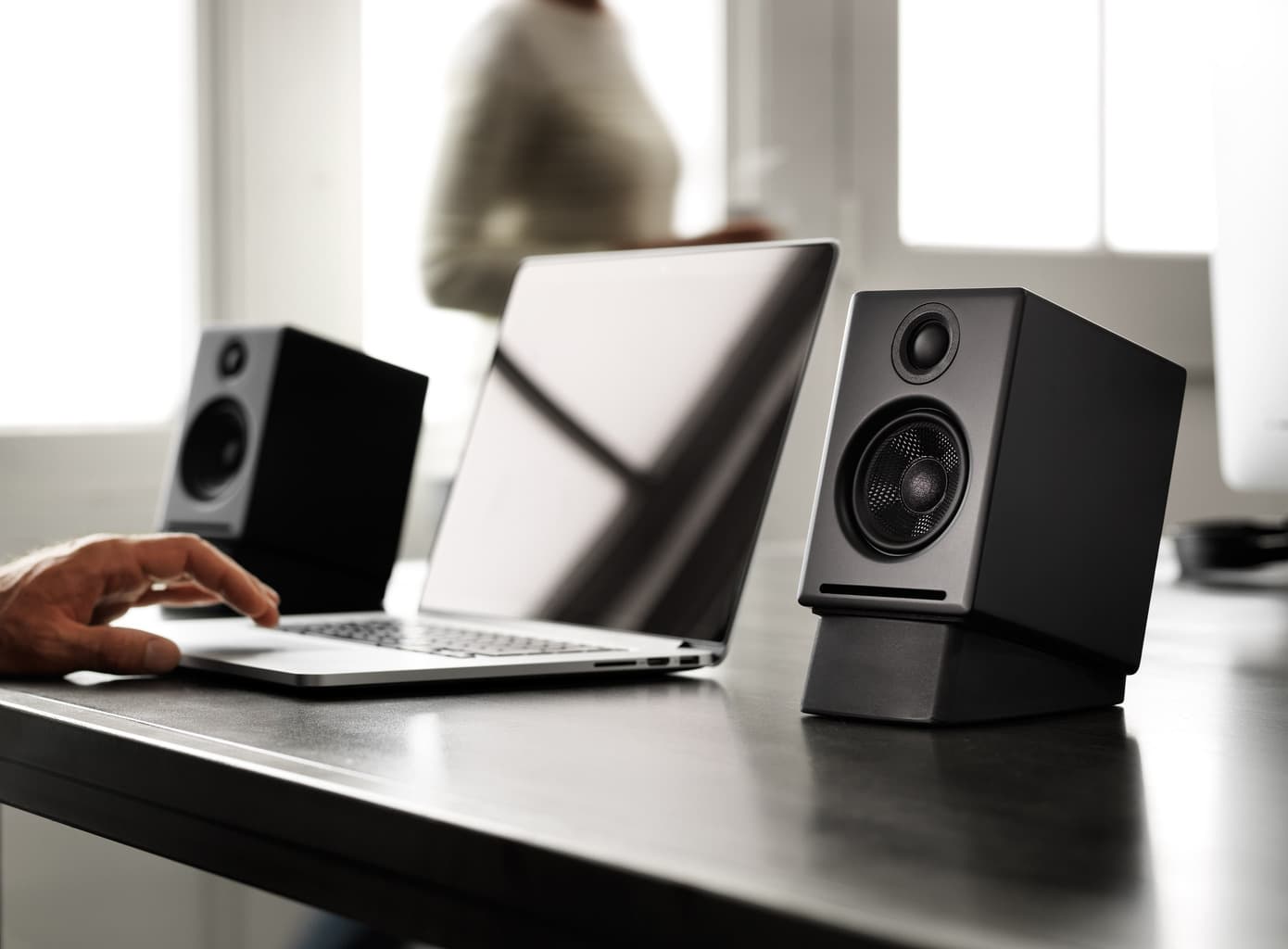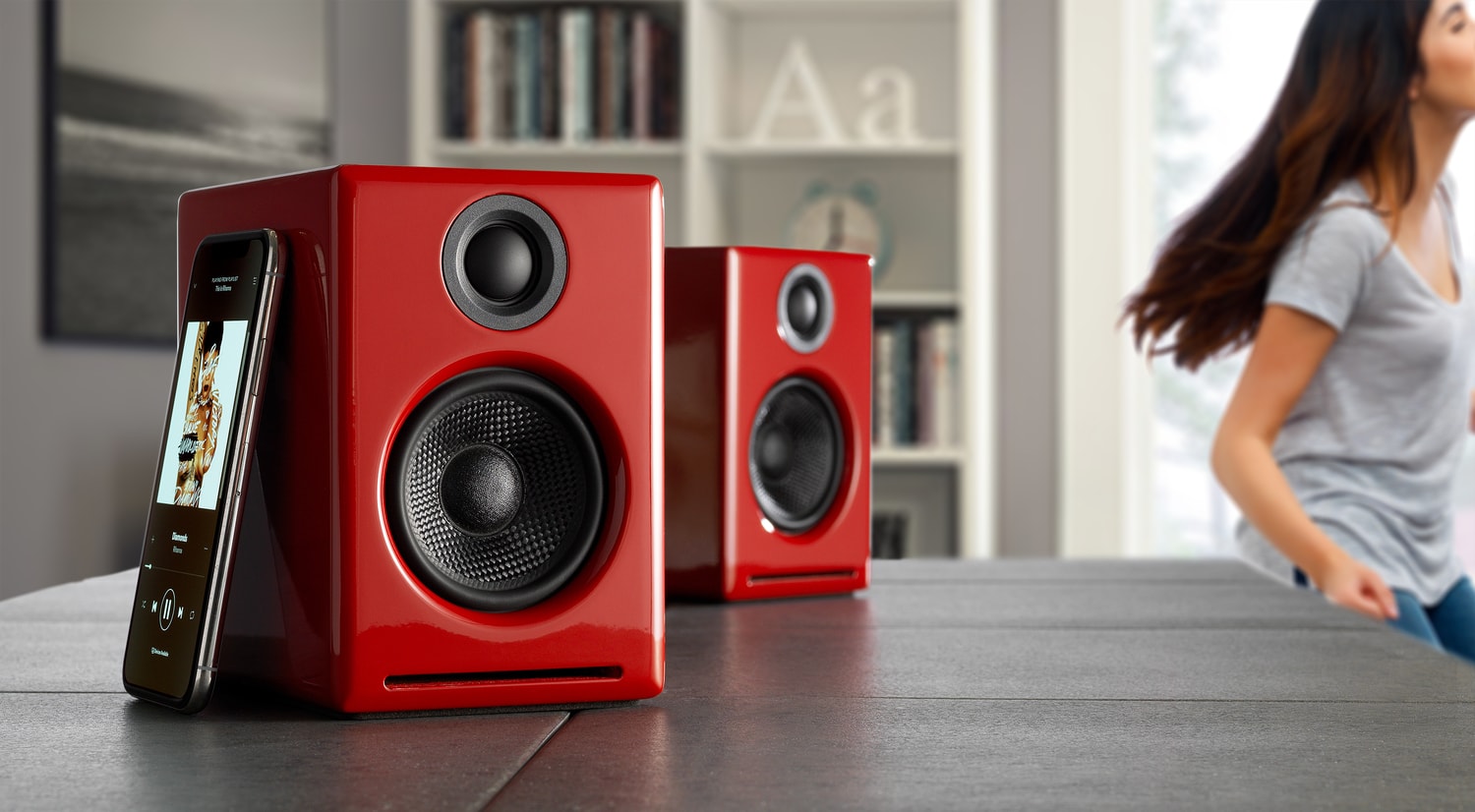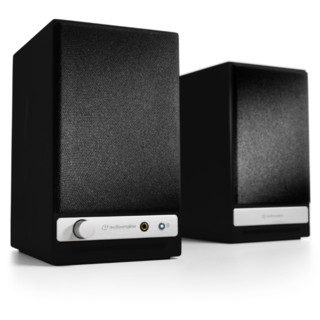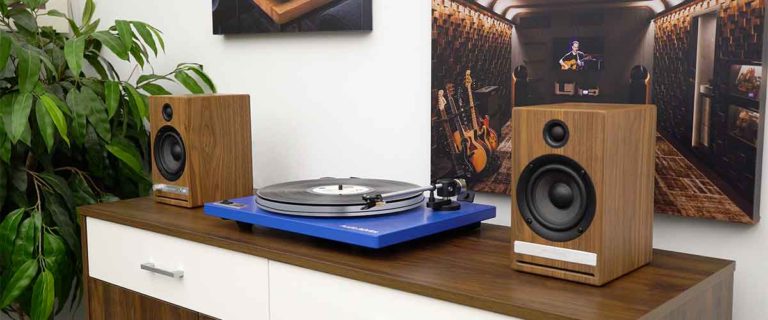The new A2+ Wireless Computer Speakers may answer the question: Just how small can a speaker system be and still sound good?
These small speakers, only 6” in height, pack a solid punch if you use them as intended and within their limits.
With built in amplifiers, the A2+ speakers are a perfect fit as a computer speaker playing multimedia material, or they can even excel in a small room playing from either an analog or digital source.
I listened to a variety of material through these speakers and was really pleased both with the quality of the output, and the accurate imaging from stereo sources.
Highlights
Audioengine A2+ Wireless Computer Speakers
- Fine sound – especially considering the diminutive size of the speakers
- Reasonably priced
- Very flexible inputs for analog and digital sources
- Very clean amplifier, delivering 15 Watts RMS per channel
- Lovely packaging and set up guide
- No remote control for volume or source switching
The Audioengine A2+ speakers come from parent company Audioengine, which has been around since 2005, making a variety of high quality speakers, usually powered varieties, that have provided excellent sound at reasonable prices. Based in Austin, Texas, the founders put in time at Apple, Harman-Kardon and Gibson Guitars. Besides speakers like the Audioengine A2+ we’re reviewing here, the company offers components like headphone amps and Bluetooth transceivers.
Tech Specs
- Dual class AB monolithic
- 60W peak power total (15W RMS / 30W peak per channel), AES
- 2.75″ aramid fiber woofers, 3/4” silk dome tweeters
- 3.5mm stereo mini-jack, RCA, USB, Bluetooth
- RCA variable line-out
- 100-240V 50/60Hz auto-switching
- >95dB (typical A-weighted) SNR
- <0.05% at all power settings THD+N
- <50dB Crosstalk
- 65Hz-22kHz ±2.0dB Freq. Response
- 5K ohms unbalanced input impedance
- Micro USB connector type
- Up to 48 kHz native input sample rate
- Bluetooth 5.0 audio
- aptX low latency, aptX, AAC, SBC supported codecs
- Available in Satin Black Gloss Red, and Gloss White
- Dimensions at 6”(H) x 4”(W) x 5.25”(D)
- Weighing at 1.6Kg/3.55lbs
Visit the tech page for full specs.
Design
As you can see from the specifications, the Audioengine A2+ Wireless Speaker System is really small. As I’ve noted, it’s designed for smaller rooms, or for use as a computer speaker. Audioengine designs and manufactures its own tweeters, woofers, and many other of the critical components in the system. Clearly, this is not a speaker assembled from other manufacturers off the shelf parts. The cabinets, bass port, drivers and the custom amplifier all work together to provide the best possible sound in a small package.
The amplifier, controls, and various ports are built into the left speaker. The right speaker connects via a standard, supplied speaker cable. The left speaker requires AC Power. The right speaker simply gets the amplified feed from the left speaker.
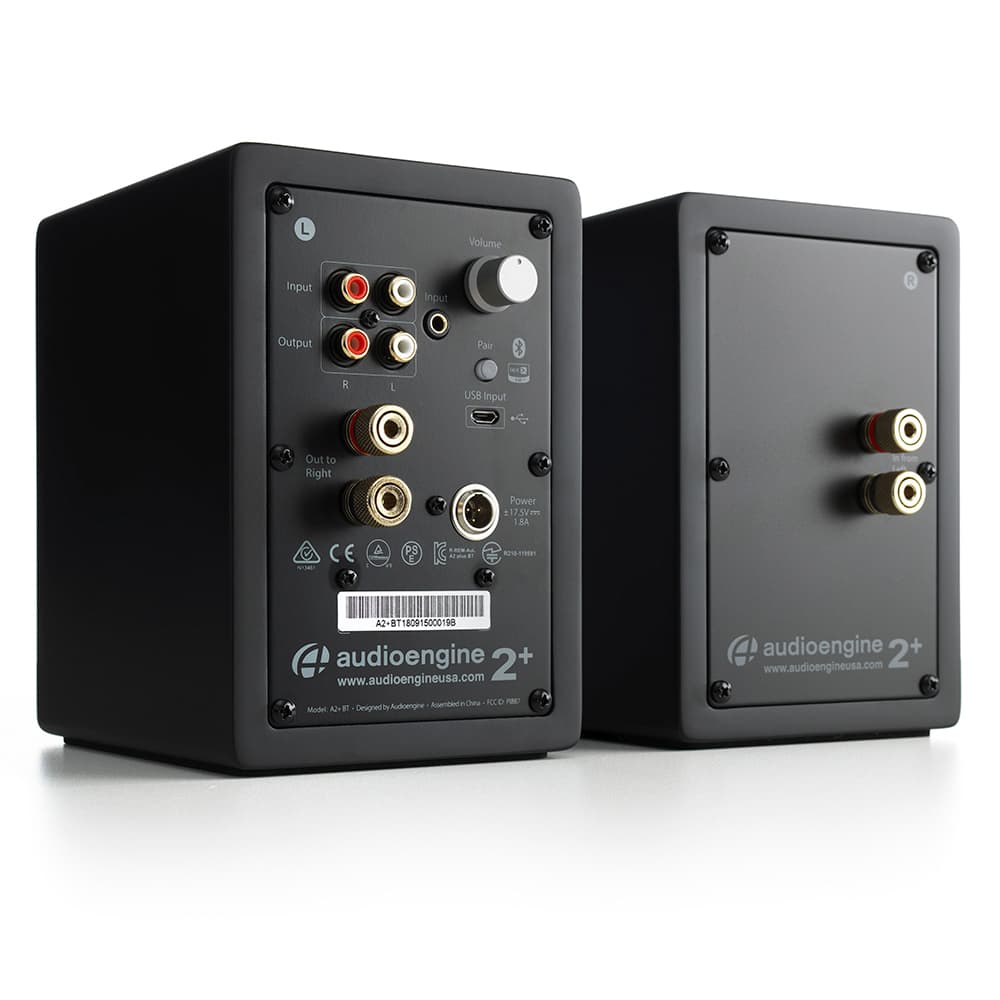
The amplifiers in the Audioengine A2+ speakers are a conservatively-rated class A/B analog monoblock design. This is a more traditional amplifier configuration which the company states provides excellent quality audio and greater flexibility. All circuit boards for the power and preamp sections are vertically mounted for maximum mechanical shock protection.
Audioengine uses audiophile-quality, ferrofluid-cooled silk dome tweeters with neodymium magnets. Silk tweeters hold up well under high power and the edge-driven design is claimed to give very smooth response. The woofers are aramid fiber woven glass composite with rubber surrounds. Aramid fiber is very strong, which means the woofer retains its shape when being driven at high levels. Both speakers are magnetically shielded, meaning they can be used as TV speakers without fear of interaction with a monitor.
Setup
The speakers arrived well packed, and were covered with a microfiber bag to protect the speaker finish.
The quick-start guide that comes with the speakers has recommendations for placement. They should be well away from walls, a common enough suggestion for many speaker designs with a bass port. Audioengine also correctly recommends you be on axis to the speaker drivers, basically that means the speakers should be pointed at the listener to get the best frequency response and imaging. I would think in a computer or desktop installation you would want to angle each speaker up so the tweeters are pointing directly at your ears, but no desktop stand is included with the A2+ system. Audioengine does offer proper stands on the accessory page of their website.
In Use
For listening to the A2+ Wireless Speakers I used a variety of input sources, including the analog inputs connected to a digital audio player. The USB input connected to my computer playing high resolution files, and finally streaming over Bluetooth from my iPhone. The iPhone does not support the APT X Bluetooth protocol, but I found the streaming quality from my phone quite good. In my average size home, I could get a few rooms away from the speakers with my phone and the audio never cut out.
I have to say I was pleasantly surprised at the quality of these little speakers. Although measured frequency response at the low end is about 65 Hz, the bass sounded really good, even with classical organ music or percussion on some rock music. The highs are also quite good, and the speakers gave a realistic account of whatever music I threw at them.
Like many small speakers, they are a bit forward in the mid-range, but the speakers never sounded harsh.
I also found the stereo image to be quite coherent giving me a convincing image of a jazz group or full orchestra spread between the two speakers. That effect requires good control of phasing as well as balanced frequency response.
Here are some of the musical performances I listened to either by streaming from my iPhone, from a CD player plugged into the analog outputs, or by playing high resolution files through a high quality DACs output using the USB input on the A2+ speakers. That input supports up to 16 bit/ 48Hz.
Frank Sinatra “Frank Sinatra: Ultimate Sinatra”
This high resolution remaster from analog sources is an excellent test of imaging and the sound of a small acoustic group of musicians. Sinatra’s voice seemed to be well placed solidly between the two speakers with the accompanying instruments nicely spread left to right.
Rebecca Pidgeon “The Raven”
Another collection of acoustic vocals that I often rely on as a good test of speakers. Ms. Pidgeon sounded very ‘live’ along with her small ensemble. I found ‘Heart and Mind’ an excellent rack to reveal the A2+ speakers midrange performance, which was a bit forward, emphasizing Ms. Pidgeon’s voice, but it was never objectionable.
Various Artists “Interstellar Soundtrack”
This music has some really deep bass and some challenging electronic music. I thought the A2+ gave a credible presentation of the bass, but it did not reach down to the deepest regions around 30 Hz. It’s just beyond the range of this little pair of speakers, but they never distorted and I could hear no sign that the woofer was under stress. Even at really high levels, I never heard any breakup on this difficult to reproduce soundtrack.
Allan Hovhaness “Mysterious Mountains”
Lovely and challenging music from the celebrated Armenian composer. On these CD tracks (ripped to FLAC) we can hear a full orchestra playing at full dynamic range. The A2+s sounded very nice, with a solid stereo image between the speakers.
Conclusions
At considerably under $300.00 I can’t think of another speaker that is as versatile and nice sounding as the Audioengine A2+ Wireless Speaker System. If you are looking for small and good, these speakers must be on your audition list.
- Compact Size
- Build quality and finish
- Excellent sound at this physical size
- Flexibility of sources, using analog inputs, Bluetooth or USB components
- Documentation
WOULD LIKE TO SEE
- Matching small subwoofer offered as a package
- Remote control
- Speaker wedges included to tilt them up
Make no mistake. These are small speakers designed for smaller rooms or use as a computer speaker. I don’t dare compare them to large floor standing speakers or flat panels. Still, considering their size, they are extremely musical, and perform well above their price point and small size. I never heard the amplifier falter, or the drivers fail to reproduce program material by breaking up or distorting.
These speakers are not meant to be room filling in a living room or den. But in a smaller room, like a home office, or bedroom they sound like they are much larger than they really are. The larger the room, the more the bass got lost, and mid-range began to prevail. That is not a surprise, nor is it a criticism. At times I wished the speaker would go a bit deeper. Audioengine makes a nice subwoofer, the S8, but at $349.00 it costs considerably more than the A2+ system. The A2+ system offers a left and right variable output on the back that can be used with a subwoofer. This is covered in the manual, but on the speaker itself the outputs are not labelled as subwoofer outs.
I also wished I had a remote control for the A2+. Since most users will be next to the speaker it’s not hard to control the volume, but the fader/power switch is on the back and requires reaching around. Sitting on either side of my computer monitor in my office the tweeters were pointing slightly below my head. In a similar setup, I’d suggest speaker wedges to tilt them up so I could be slightly more on-axis to the output.
In summary, I’ve heard larger speakers selling for a similar or slightly increased price that sound very close to overall and even slightly deeper in the low end. Still, I can’t imagine anything at this size sounding better.
Read full review here.


